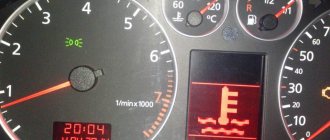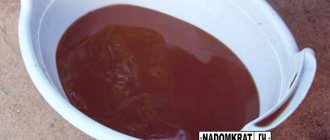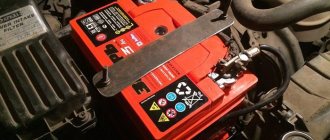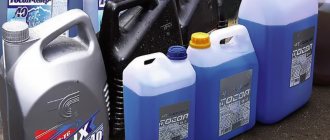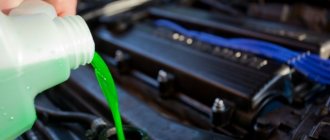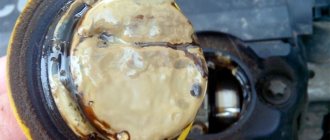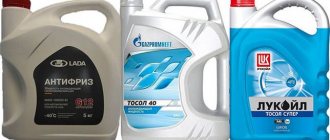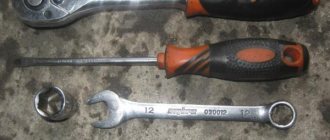Antifreeze is the most famous domestic antifreeze for car cooling systems. When choosing this substance, it is necessary to evaluate a number of its parameters. First of all, this is the quality of the product on sale. The correct operation of the vehicle systems and their durability will depend on this.
The density of antifreeze is one of the most important characteristics, which allows the buyer to evaluate its performance qualities. After all, antifreeze compliance with modern requirements is a guarantee of the correct operation of all mechanisms.
General characteristics and composition
To understand how to measure the density of antifreeze and antifreeze, you need to understand their characteristics and definition. The presented substance is needed to cool the engine in summer and protect it from mechanical destruction in winter.
The name of antifreeze is based on an abbreviation. TOS – technology of organic synthesis. The last two letters of the name indicate that the substance belongs to the group of alcohols, which, as is known, end in “ol”.
The basis of antifreeze is glycol ether. The composition includes about 10 different additives. Thanks to this, antifreeze is not susceptible to frost or heat, does not boil or foam. Special additives eliminate the impact on mechanism materials, making them non-corrosive. Antifreeze can also be stored and used for a long time due to its special composition.
What characterizes density?
The density of antifreeze can tell a lot about the state of this substance during operation. Therefore, it is required to check it regularly. This indicator is influenced by several main factors. First of all, this is the composition and recipe for the production of antifreeze. Each manufacturer uses a specific technology in the production of its refrigerant.
The second important factor is the quantity and set of additives. These components improve the performance of antifreeze and additionally protect systems and mechanisms from premature wear. During the production process, technologists use a certain set of these additional components. They are clearly balanced. Some of them are incompatible and depend on the operating conditions of the equipment.
The last important factor that affects the density of antifreeze is the amount of monoethylene glycol in it. All these features affect heat capacity and thermal conductivity. If the density of antifreeze changes, this can lead to dire consequences.
Main indicators of coolant
Among the mandatory information indicated on the packaging of antifreeze are its main indicators. These include:
- appearance (transparent liquid of a certain color);
- crystallization temperature;
- boiling point;
- foamability;
- alkalinity;
- corrosion loss of metals;
- kinematic viscosity;
- compound;
- density.
And also some others. The last indicator on the list will be discussed.
How to measure density yourself?
When considering how to check the density of antifreeze, you should pay attention to the simplest methods. Special equipment helps to take measurements for any liquid. This device is called a hydrometer. It is easy to use. In this case, only a few simple steps are performed.
First, open the hood. Next, you should find the expansion tank, which contains the antifreeze. Its lid opens. The required amount of antifreeze is taken with a hydrometer. To do this, a pipette is lowered into the refrigerant and the substance is drawn into the flask. The float must balance freely.
It is necessary to measure the antifreeze concentration on the hydrometer scale. Next, the obtained result is compared with the nominal value specified by the manufacturer. In some cases, the density may be lower or higher than stated. This can also be affected by the amount of water in the solution.
About the operation of the cooling system
Often while driving, especially when it is hot outside, the antifreeze in the expansion tank boils. Why this happens and how to fix it is of primary interest to the car owner. To eliminate the malfunction, you need to understand how the cooling system works. Otherwise, it will be quite problematic to identify the cause of the problem and fix it on the spot.
When starting the engine, it is in an unheated state. Therefore, antifreeze circulates only in a small cooling circle. It includes:
- engine water jacket;
- stove;
- thermostat.
At this moment, the liquid level in the tank is within normal limits. As the power unit warms up, a large circulation circuit begins to open, passing through the main radiator. This leads to the fact that the volume of technical fluid in the system expands. Its excess ends up in the tank. As the pressure increases, it is partially relieved using a bypass valve. It is present on the lid of the working container.
When antifreeze reaches a temperature of 95 degrees Celsius, it increases in volume to maximum values. Its excess is discharged through the upper radiator pipe. For this reason, many motorists have the impression that antifreeze is boiling in the expansion tank. Any experienced car enthusiast can explain why this happens.
Depending on the design of the system in a particular car, the cap with the valve can be installed either on the radiator neck, or placed directly on the tank. In the second case, the release occurs only after the pressure has risen. This working vessel communicates with the atmosphere through an opening present in the plug.
Measurement result
Now you know how to check the density of antifreeze with a hydrometer, now you need to understand the result obtained.
The density indicator is affected by the water used to dilute antifreeze in a factory or at home. As its content in the solution increases, the freezing point of the substance becomes higher, and the cooling characteristics deteriorate in the summer.
If the density of a substance is underestimated when measured, this means that the antifreeze contains a large amount of water. In this case, the operating temperature range of antifreeze becomes narrower. This is a negative trend.
An increased concentration indicates a decrease in the cooling and lubrication properties of mechanisms. Because of this, they wear out quickly. Therefore, it is necessary to compare the nominal density value stated on the packaging with the hydrometer readings. If necessary, it is adjusted.
Low antifreeze level
What is better antifreeze or antifreeze?
One of the reasons for antifreeze boiling may be its lack in the system. This happens when the cooling system charge level is insufficient. The filling arrow on the tank body should be between o and “max”.
Low coolant levels can occur when there is a coolant leak. And given that the boiling point of antifreeze at pressure is higher than in a depressurized system, the combination of these factors becomes the cause of an emergency.
Leaks happen anywhere. It needs to be found and eliminated. Any damage to components of cooling structures must be repaired immediately.
Normative value
One of the most popular types of the substance presented is antifreeze brand A-40 or A-40M. This refrigerant is used in relatively warm climates where the temperature in winter does not drop below -38°C. Among car enthusiasts in our country, it is widely believed that the density of antifreeze A-40 is 1.075 g/cm³. In this case, the mixture contains about 44% water and 56% ethylene glycol (or higher).
The density indicator depends on the temperature at which the measurement was taken. Standards set the permissible norm of this value at 1.065-1.085 g/cm³. In this case, the ambient temperature should be at +20°C.
If the number obtained during measurements does not correspond to this indicator, it can be adjusted. To do this, drain off a little old antifreeze and add either water or antifreeze concentrate to the overall mixture.
Water
Let's start, of course, with plain water.
There are quite a few advantages here . Firstly, water is practically free (and if you have your own well drilled, it’s completely free). Secondly, it is almost always available (it is available 24 hours a day from the tap, there is no need to go to stores and buy it), so you can always add it to your heating system without problems. Thirdly, water is not toxic, if you spill it you don’t need to dispose of it, just wipe it with a rag and that’s it. Fourthly, it heats up well and tolerates heat well, which is why it is used in heating systems. Fifthly, it has good fluidity, is not viscous, and therefore is suitable even for thin heating pipes.
BUT there are also disadvantages and they are no less significant . Firstly, water oxidizes metals very well, rust appears, and then deposits that clog your radiators (heating efficiency drops significantly). Secondly, if you heat the water to more than 80 degrees, scale can be deposited on the walls of pipes and radiators, which also clogs the pipes and reduces heating efficiency. Thirdly, water freezes already at “0” degrees, which means that the system cannot be left unplugged in winter; the water will simply freeze and destroy the pipes and boiler. Fourthly, according to research, heating water requires about 10% more energy (gas or electricity), which means you spend more money on heating. Also, water cools faster than antifreeze, water needs to be heated more often, which means gas or electricity consumption increases (you pay more money). And lastly, it is advisable to flush the system every year, otherwise it may simply become clogged with rust and deposits.
Lifetime
Knowing what density of antifreeze currently affects the car’s systems, as well as what the standard value of this indicator is, you can avoid premature repairs or car breakdowns. Over time, antifreeze ages. Its service life depends on the quality of the antifreeze itself and the mileage of the car.
If the density of the mixture is low, there is a large amount of water in the solution. It impairs the effect of additives and provokes the formation of corrosion. This leads to rapid destruction of the surfaces of mechanisms. In this case, the liquid takes on a rusty tint. Regardless of the service life of such a substance, it should be replaced immediately with new antifreeze.
A little physics
It is incorrect to talk about the boiling point of antifreeze in the specifics of antifreeze, since, firstly, antifreeze has a certain chemical composition, and its thermophysical characteristics are determined not only by temperature, but also by pressure. Secondly, antifreeze, which at one time was created exclusively for domestically produced engines, contains additives that ensure not only the operation of the car at low temperatures, but also its protection from a number of unfavorable factors:
- corrosion;
- wear;
- cavitation.
Antifreeze, unlike antifreeze, does not have a lubricating effect, and wear reduction is achieved due to a decrease in the temperature of the moving elements of the drive, with an increase in which the gaps are selected and the friction coefficient naturally increases.
If everything is more or less clear with the permissible temperature (no more than 90ºС), then with the pressure in the engine the situation is more complicated. To protect the engine from overheating, antifreeze is pumped at elevated pressures, which also affects the temperature of the liquid. For most brands, the actual pressure in the cylinder block is at least 1.2...1.3 at: it is then, according to the Clausius law, that the maximum temperature required for boiling liquids increases. Thus, the theoretically permissible boiling point of coolants can be 110...112ºС.
How to change antifreeze
If you have measured the density of antifreeze, assessed its visual characteristics and determined the need to replace this substance, you need to carry out a special procedure. Warm up the engine for 5 minutes. The heater valve in the cabin must be open. After stopping the engine, the old antifreeze is drained and clean water is poured in instead. You can use a special cleaning agent. It is used in accordance with the manufacturer's instructions.
Through the drain plug, which is located in the radiator, water is removed from the system. Rinsing is done until the liquid becomes clear. After this, you can fill in new antifreeze.
Having studied what the density of antifreeze is, you can understand the importance of measuring it. This indicator will allow you to evaluate the correct operation of the entire system and prevent its breakdown.
Authentication
Unfortunately, it is almost impossible to identify counterfeit antifreeze when purchasing. To do this, you can only submit samples for analysis, spending a lot of time and money.
But there is a much simpler verification option.
Fake and low-quality antifreeze quickly loses its characteristics.
This is due to the fact that in order to reduce the cost of production, scammers replace ethylene glycol with sugar, salt, acid, etc. That is, when checked with a hydrometer, the density parameters will be normal. But in practice, such a liquid will freeze even in slight frost.
To check the quality of the coolant, you need to make an initial control measurement. If it is normal, the composition is poured into the cooling system. During the week you can drive a car. Then, after a week, the coolant is taken from the car and the density is checked again:
If you continue to operate a car with low-quality fluid, this will negatively affect the condition of the engine. Antifreeze can damage the internal combustion engine and cause a number of unpleasant and expensive malfunctions.
Source


